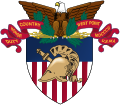
The United States Military Academy (USMA), also known as West Point, Army, Army West Point, The Academy, or simply The Point, is a four-year federal service academy in West Point, New York. It was originally established as a fort, as it sits on strategic high ground overlooking the Hudson River with a scenic view, 50 miles (80 km) north of New York City. It is the oldest of the five American service academies and educates cadets for commissioning into the United States Army.

George Smith Patton Jr. was a general in the United States Army who commanded the Seventh United States Army in the Mediterranean theater of World War II, and the Third United States Army in France and Germany after the Allied invasion of Normandy in June 1944.

Thomas Ball was an American sculptor and musician. His work has had a marked influence on monumental art in the United States, especially in New England.

Omar Nelson Bradley was a senior officer of the United States Army during and after World War II, rising to the rank of General of the Army. Bradley was the first chairman of the Joint Chiefs of Staff and oversaw the U.S. military's policy-making in the Korean War.

Felix Weihs de Weldon was an Austrian-born American sculptor. His most famous pieces include the United States Marine Corps War Memorial in the Arlington National Cemetery, Virginia, US, and the Malaysian National Monument (1966) in Kuala Lumpur.

The 12th Armored Division was an armored division of the United States Army in World War II. It fought in the European Theater of Operations in France, Germany and Austria, between November 1944 and May 1945.
The General George Patton Museum of Leadership is a museum in Fort Knox, Kentucky, dedicated to the memory of General George S. Patton, Jr., and his role as a leader from World War I to the present day. The museum is administered by the U.S. Army Cadet Command, Fort Knox and the U.S. Army Training and Doctrine Command.

Poklonnaya Gora is, at 171.5 meters, one of the highest natural spots in Moscow. Its two summits used to be separated by the Setun River, until one of the summits was razed in 1987. Since 1936, the area has been part of Moscow and now contains the Victory Park with many tanks and other vehicles used in the Second World War on display.

Paul Donal Harkins was a career officer in the United States Army and attained the rank of general. He is most notable for having served during World War II as deputy chief of staff for operations in George S. Patton Jr.'s commands, and as the first Military Assistance Command, Vietnam (MACV) commander, a post he held from 1962 to 1964.

The military career of Dwight D. Eisenhower began in June 1911, when Eisenhower took the oath as a cadet at the United States Military Academy at West Point. He graduated from West Point and was commissioned as a second lieutenant in the United States Army in June 1915, in the same class as Omar Bradley. He rose through the ranks over the next thirty years and became one of the most important Allied generals of World War II, being promoted to General of the Army in 1944. Eisenhower retired from the military after winning the 1952 presidential election, though his rank as General of the Army was restored by an act of Congress in March 1961.

The General George S. Patton Memorial Museum, in Chiriaco Summit, California, is a museum erected in tribute to General George S. Patton on the site of the entrance of Camp Young, part of the Desert Training Center of World War II.

Walker Kirtland Hancock was an American sculptor and teacher. He created notable monumental sculptures, including the Pennsylvania Railroad World War II Memorial (1950–52) at 30th Street Station in Philadelphia, Pennsylvania, and the World War I Soldiers' Memorial (1936–38) in St. Louis, Missouri. He made major additions to the National Cathedral in Washington, DC, including Christ in Majesty (1972), the bas relief over the High Altar. Works by him are at the United States Military Academy, the Library of Congress, the United States Supreme Court Building, and the United States Capitol.

Franklin Bachelder Simmons was a prominent American sculptor of the nineteenth century. Three of his statues are in the National Statuary Hall Collection, three of his busts are in the United States Senate Vice Presidential Bust Collection, and his statue of Ulysses S. Grant is in the United States Capitol Rotunda.

Yad La-Shiryon is Israel's official memorial site for fallen soldiers from the armored corps, as well as one of the most diverse tank museums in the world. The cornerstone for Yad La-Shiryon was laid on December 14, 1982.

Benjamin Oliver Davis Jr. was a United States Air Force (USAF) general and commander of the World War II Tuskegee Airmen.

America's Response Monument, subtitled De Oppresso Liber, is a life-and-a-half scale bronze statue in Liberty Park overlooking the National September 11 Memorial & Museum in New York City. Unofficially known as the Horse Soldier Statue, it is the first publicly accessible monument dedicated to the United States Special Forces. It was also the first monument near Ground Zero to recognize heroes of the September 11 terrorist attacks.

A 1953 statue of George S. Patton by James Earle Fraser is installed along Boston's Charles River Esplanade, in the U.S. state of Massachusetts.

















